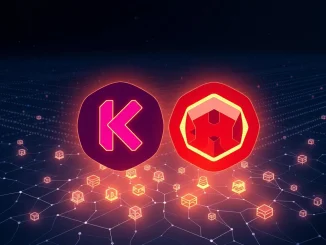
A major tremor is shaking the decentralized finance (DeFi) world as a crypto whale on Spark Protocol, previously known as MakerDAO, teeters on the brink of a massive liquidation event. This situation highlights the inherent volatility and potential pitfalls within the seemingly lucrative DeFi space. Let’s dive into the specifics of this developing story and understand what it means for the broader cryptocurrency market.
Why is This ETH Whale Facing Liquidation on Spark?
According to on-chain data sleuths at Lookonchain, a significant ETH whale is currently facing a potential liquidation of a staggering $135.8 million worth of Ethereum (ETH). This precarious situation is unfolding on Spark, a lending protocol in the DeFi ecosystem. The whale’s substantial holdings of 65,675 ETH are now at risk due to a dangerously low ‘health rate’ of just 1.05.
But what exactly does a ‘health rate’ mean in the context of DeFi lending, and why is 1.05 a cause for alarm? In platforms like Spark, users can deposit assets as collateral to borrow other cryptocurrencies. The ‘health rate’ is a crucial metric that indicates the safety margin of a loan. It’s essentially a ratio that reflects the value of your collateral relative to your borrowed amount, factoring in market fluctuations. A health rate of 1.05 signifies a very thin margin – meaning the value of the collateral is only marginally higher than the borrowed amount.
When the health rate drops too low, approaching or falling below 1, it triggers a liquidation event. This is a mechanism designed to protect the protocol and its users. In this case, the liquidation price for this whale’s ETH collateral is set at $1,931.83. If the price of ETH dips to or below this level, the whale’s position could be automatically liquidated to repay the borrowed funds and maintain the protocol’s solvency.
Understanding the Liquidation Threshold and Market Impact
To better grasp the gravity of this situation, let’s break down the key elements:
- Collateral: 65,675 ETH (valued at $135.8 million at the time of reporting)
- Platform: Spark Protocol (formerly MakerDAO) – A popular DeFi lending platform.
- Health Rate: 1.05 – Dangerously low, indicating minimal safety margin.
- Liquidation Price: $1,931.83 – The price point at which liquidation will be triggered.
The potential liquidation of such a large ETH position could have ripple effects across the cryptocurrency market. Here’s why:
- Price Volatility: A sudden dump of 65,675 ETH into the market could exert significant downward pressure on the price of Ethereum, and potentially other cryptocurrencies.
- DeFi Market Sentiment: Such a high-profile liquidation event could negatively impact investor sentiment towards DeFi protocols, raising concerns about risk management and volatility within the sector.
- Cascading Liquidations: In a highly interconnected DeFi ecosystem, a large liquidation can sometimes trigger a cascade of liquidations if other borrowers also see their collateral value decrease.
What is Spark Protocol and Why is it Relevant?
Spark Protocol, evolving from MakerDAO’s legacy, is a prominent player in the DeFi lending space. It allows users to borrow and lend cryptocurrencies in a decentralized and permissionless manner. Platforms like Spark are crucial to the DeFi ecosystem, enabling users to leverage their crypto assets for various purposes, such as trading, yield farming, or accessing liquidity without selling their holdings.
However, this case serves as a stark reminder of the risks associated with DeFi lending. While these platforms offer attractive opportunities, they also come with inherent dangers, including:
- Volatility Risk: The value of cryptocurrencies can fluctuate dramatically, leading to rapid changes in health rates and potential liquidations.
- Smart Contract Risk: DeFi protocols rely on smart contracts, which, while generally secure, are not immune to bugs or exploits.
- Complexity: Navigating DeFi protocols and understanding concepts like health rates and liquidation prices can be complex for newcomers.
Actionable Insights: Navigating the Volatile Crypto Landscape
This developing situation offers several key takeaways for anyone involved in cryptocurrency, especially DeFi:
- Monitor Health Rates Diligently: If you are using DeFi lending platforms, closely monitor the health rate of your positions and ensure you have sufficient collateral buffer to withstand market downturns.
- Understand Liquidation Mechanisms: Familiarize yourself with the liquidation process of the platforms you use to avoid unexpected position closures.
- Diversification is Key: Don’t put all your eggs in one basket. Diversify your crypto holdings and DeFi activities to mitigate risk.
- Stay Informed: Keep abreast of market news and on-chain data to anticipate potential volatility and risks.
The Road Ahead: Will the Whale Avoid Liquidation?
The crypto community is watching closely to see if this ETH whale can avert liquidation. Several scenarios could play out:
- ETH Price Increase: If the price of Ethereum rebounds above $1,931.83, the whale’s health rate will improve, reducing the immediate liquidation risk.
- Collateral Top-Up: The whale could deposit more ETH to increase their collateral and improve their health rate.
- Position Closure: The whale might proactively close part or all of their position to avoid the risk of forced liquidation.
Ultimately, this situation serves as a crucial lesson in risk management within the fast-paced and often unpredictable world of cryptocurrency and DeFi. It underscores the importance of understanding the mechanics of these platforms and being prepared for market volatility. As the situation unfolds, it will undoubtedly provide further insights into the resilience and risks inherent in the decentralized financial ecosystem.



